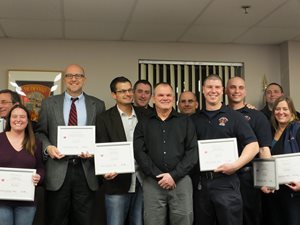 Ray Billings didn’t feel like himself that morning, but he and his wife still laced up and headed out to Millennium Running’s HPM Insurance Snowflake Shuffle at the Copper Door in Bedford. It was January 15 and Ray remembers, “My lungs were cold. I didn’t want to run; I didn’t feel up to it, but it saved my life.”
Ray Billings didn’t feel like himself that morning, but he and his wife still laced up and headed out to Millennium Running’s HPM Insurance Snowflake Shuffle at the Copper Door in Bedford. It was January 15 and Ray remembers, “My lungs were cold. I didn’t want to run; I didn’t feel up to it, but it saved my life.”
Less than a mile in to the course, Ray started to feel very strange. People around him were asking if he was ok. “I didn’t even realize I was already on the ground,” he recalls. He was going into cardiac arrest. By the time his wife Kristine, who was also running, came upon the scene, Ray had turned purple.
Fortunately for Ray, runners have proven themselves time and again, springing into action in an emergency. “With more than 2,000 runners on the course, the first person to act when someone has an emergency is likely going to be another runner,” says John Mortimer, the owner of Millennium Running who is a strong advocate for CPR education and has seen runners save lives in other races as well. In this particular race, several people stopped to help including Dr. Robert Capodilupo, a cardiologist at Catholic Medical Center’s New England Heart & Vascular Institute.
“The most vivid image that comes to mind from that morning,” recalls Dr. Capodilupo, “is how compassionately the local running community quickly reacted to the needs of a fellow runner. The great outcome achieved was not only due to the quick responses of many, but also the team effort displayed
that day.”
That team effort represented what the American Heart Association calls the Chain of Survival—five critical steps to saving a life: immediate recognition of a cardiac event and activation of the emergency response system; early CPR with an emphasis on chest compressions; rapid defibrillation; effective advanced life support and integrated post-cardiac arrest care. Where the runners left off, Bedford Fire Department first responders took over, providing Ray with defibrillation and advanced life support both on the scene and on the way to CMC’s Emergency Department.
By the time the ambulance reached CMC, Ray was alert enough to to give his name, date of birth, and his wife’s phone number. Ray was already aware of the importance of CPR, even before it saved his own life. “I’ve been meaning to become a certified trainer,” he says, noting the paperwork to do so is sitting on his desk. Words cannot express how much Ray and Kristine, who have five children, appreciate that someone else knew what to do when he went into cardiac arrest. By becoming a certified trainer Ray will ensure others can get the same life saving care.